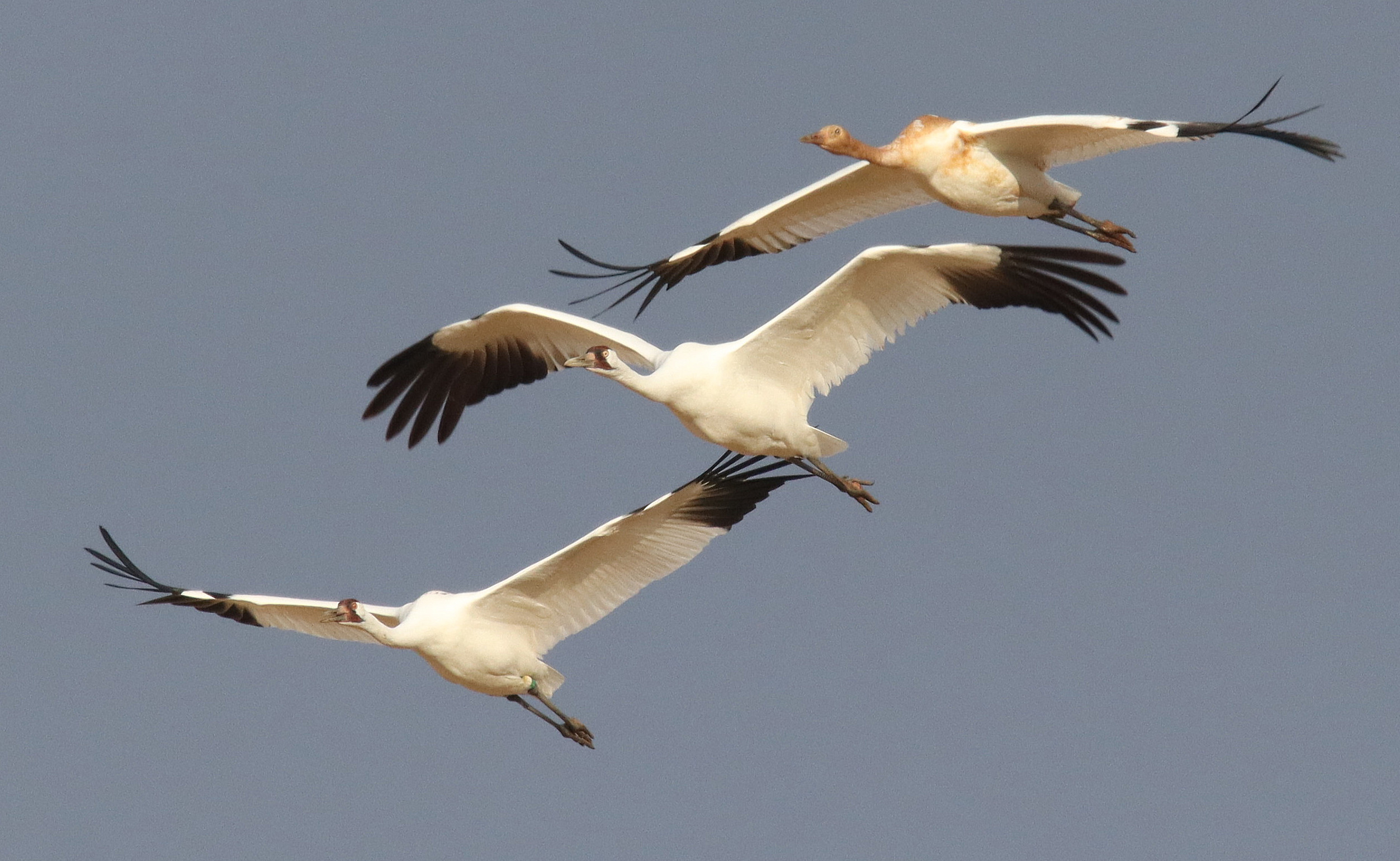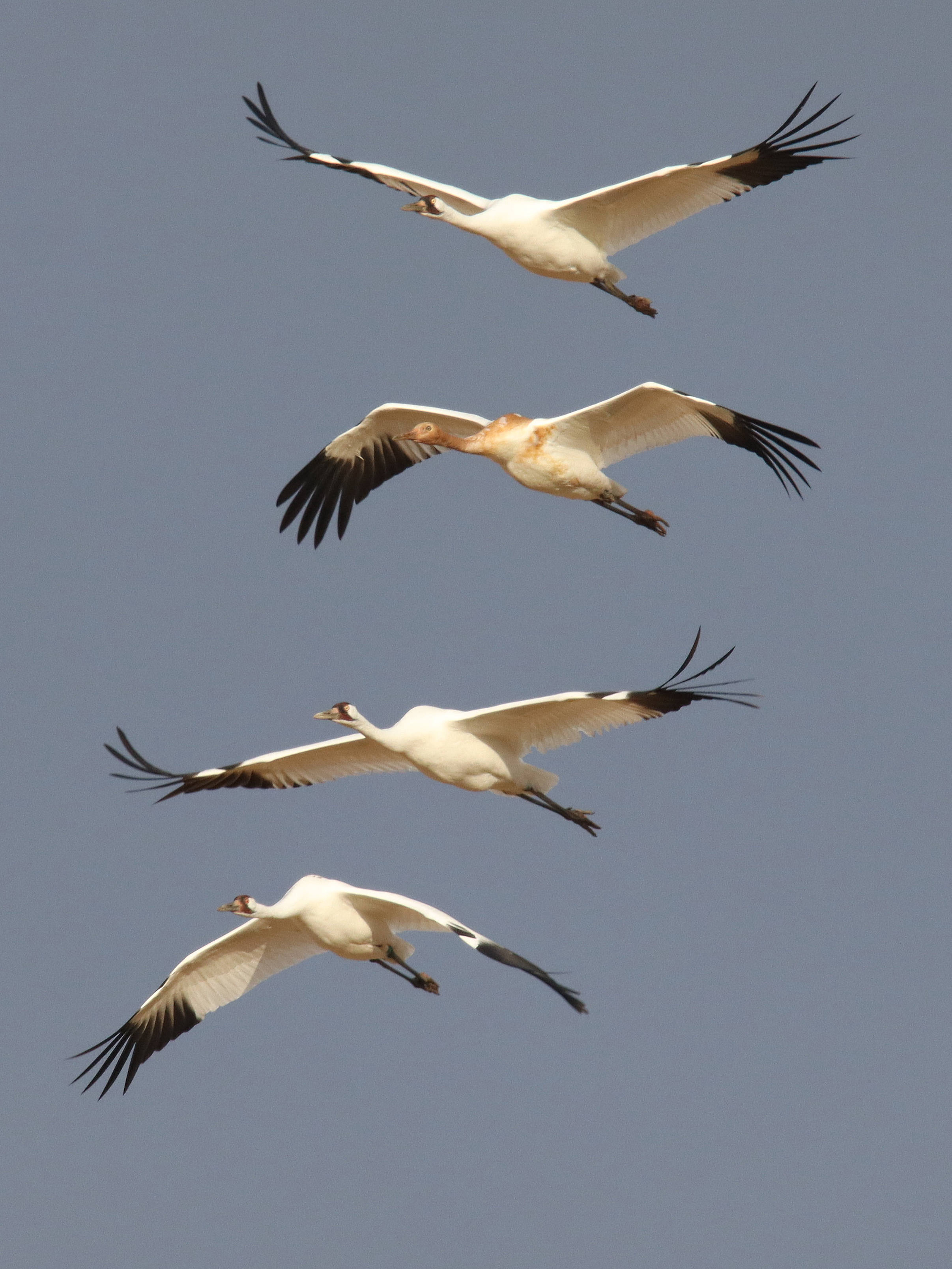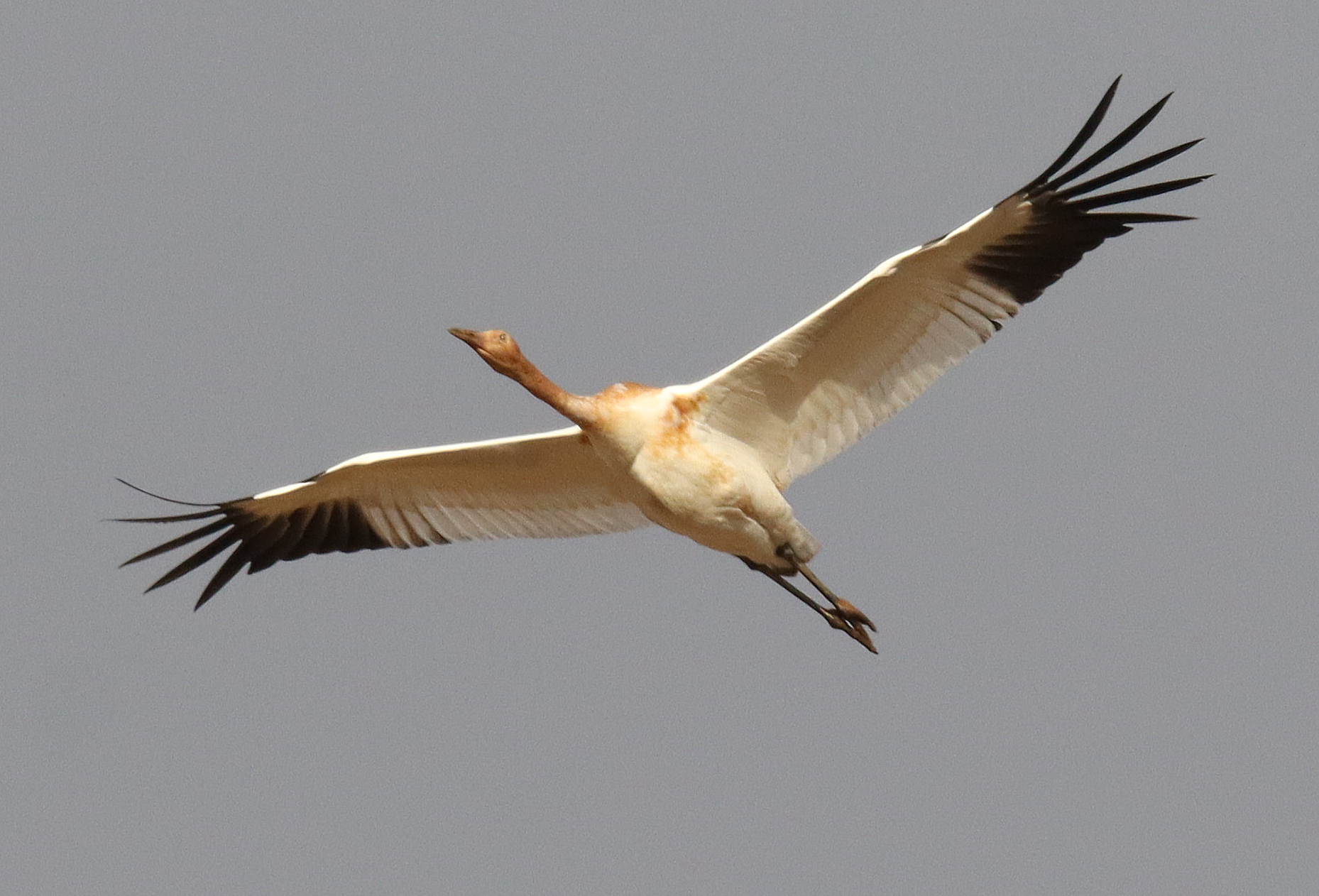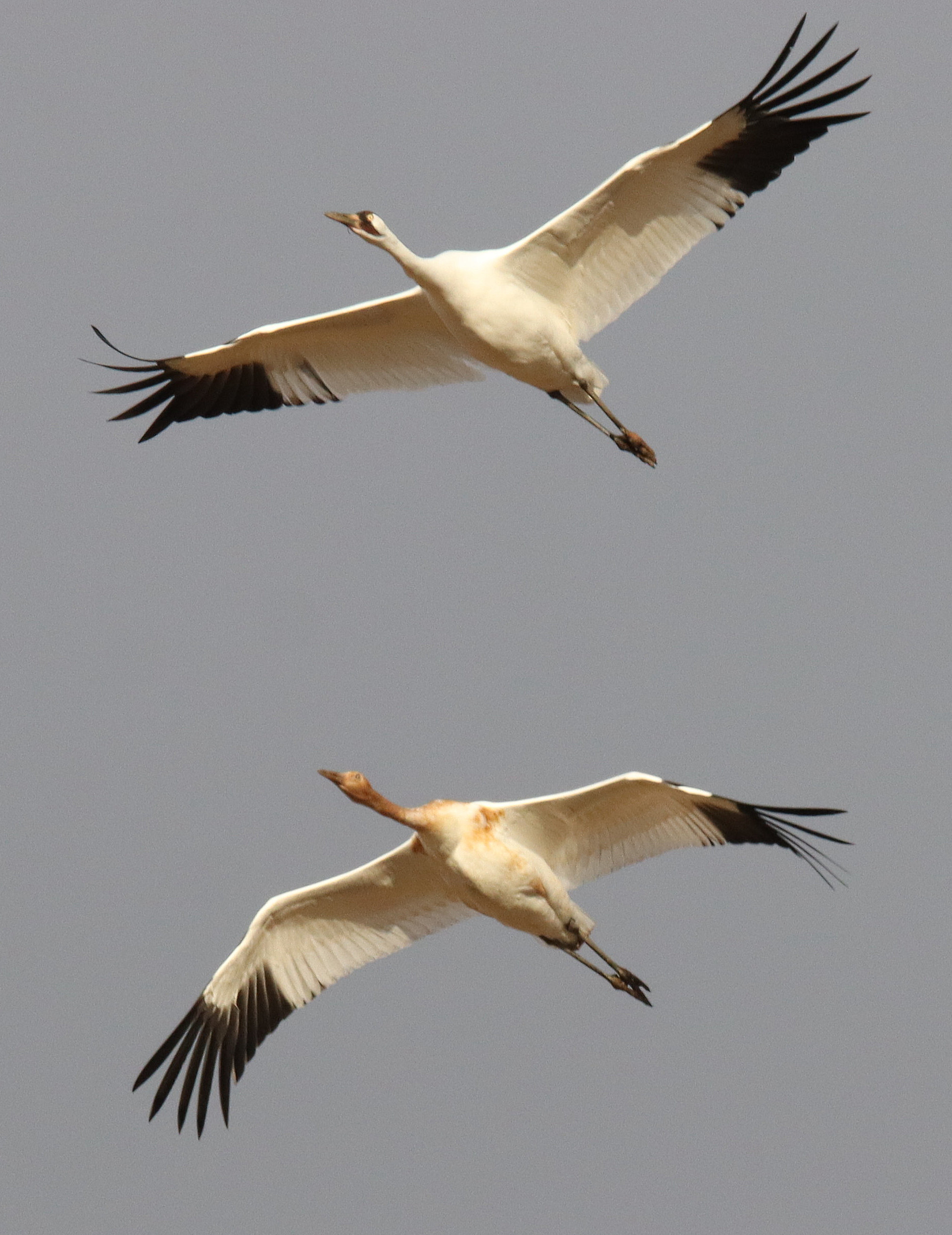
A family group flying in close proximity just after the sun broke through the low clouds Monday afternoon.

Four of the 11 Whooping Cranes that provided some of the best photo opportunities to date, although any observations of Whooping Cranes are especially exciting.

A young Whooping Crane has distinctive rufous-colored plumage on its head, neck, and some dorsal plumage. The young crane will remain with the adult pair until next spring.

We will let the last 3 paragraphs of Paul’s text tell the story behind these photographs – probably the best Whooping Crane photos he has taken to date.
|
At sunset Saturday, a text dinged on my cellphone, and when I glanced at it, there was a photo with the message “14 Whoopers, 2 young ones!” I expected it was from my friends Chris and Barb, and sure enough, Barb sent me 3 photos she took with her cellphone, noting the Whooping Cranes were south of Bismarck along the Missouri River, about 100 miles from home. It’s that kind of totally unexpected information that changes my schedule pretty quick – I would have left immediately if there was daylight a few more hours, but tomorrow would do.
I called to get the scoop from my Bismarck High School classmates and appreciated their information and the exciting tip. Seeing Whooping Cranes during a migration stop between northern Canada and the Gulf Coast is one of the rarest sightings of all, especially given that there are only about 550 Whoopers in the original migratory population! As noted, it would be raining all day Sunday, but Monday would be bright and sunny for photography.
The Next Morning: Suddenly I was looking face to face with 10 Whooping Cranes flying straight at me, so close I could only get 2 in my camera lens at a time! I was standing beside my white car, which obviously stood out, but it didn’t seem to impede the progress of the cranes, their extra-long wings pumping gracefully as the Whoopers trumpeted to one another – 8 adults and 2 young of the year. As I turned my zoom lens to a lower magnification to fit more birds in the photo frames, the birds angled broadside before me, passing by less than 15 feet above my head – wooo!
The only downside was that it was terribly overcast and about to rain, making my photos barely sharable, aside from documenting my story. But I’m sure the Whooping Cranes will remain some days, especially with southeast wind predicted for Monday and Tuesday. I watched the cranes circle over a shallow wetland connected to the Missouri River south of Bismarck where there were 6 more Whooping Cranes waiting. I expected 14, after my friends Chris and Barb filled me in on their Saturday sightings.
Back to the beginning of my Whooper interactions, I arrived about 40 minutes after sunrise Sunday morning, expecting the cranes might already be feeding in the harvested cornfield where they were feeding the day before. My first look throughout the area came up empty so I checked the shallow lagoons in the river floodplain, but as I was riverside, I saw 2 flashes of white rise above a nearby field, then a flock of large bright white birds – Whooping Cranes, but I lost track of them and couldn’t relocate the cranes initially, even though these tall white birds really stand out in an open field or wetland.
Soon I found a family group – 2 adults and their single rufous and white-colored juvenile, feeding a quarter mile into the cornfield. I watched them and documented the location with a couple photos, and that’s when a pair of Whoopers flew into view, following the riverside, then turning in my direction, and flying ever-closer until they were almost directly overhead as they headed toward the family group, where they landed. I looked for other Whoopers in nearby fields, but found none; so returned to the roadside where I could observe the 5 cranes.
In a few minutes I heard cranes calling; I searched the sky for cranes but saw none, then 5 more Whooping Cranes flew into view, greeted by the calls of the cranes on the ground. (Hearing the calls of several Whooping Cranes is a remarkable birding event!) The 5 new Whoopers, a family group of 3 and a pair, parachuted out of the sky to land near the others, making the initial group of 10 Whoopers – the most I’ve ever witnessed in many years of monitoring Whooping Crane migration. After they fed 20 more minutes or so, the cranes became alert and I looked for more cranes, geese, or an eagle approaching; but they were merely ready to return to their roost site, and suddenly stretched their necks forward and took flight, headed south into the wind and providing some nice long-lined flock photos.
That’s when they turned and flew directly toward me, and my jaw must have dropped open facing 10 Whooping Cranes head-on. That takes us back to the beginning of this field report, and seeing 16 Whooping Cranes together during a migration stopover in an area I have visited since I was a young boy; it was truly rewarding. Before returning home I took a few photos to document the 16 Whooping Cranes in the shallows on the edge of a sizeable open marsh, with water supplied by overflow from the mighty Missouri River, just south of Barb and Chris’s hilltop getaway. It was a thrilling 90 minutes, but without sun to photograph the birds, I knew I would return – possibly a number of times.
Along the way home I also checked out feeding Sandhill Cranes about 4 miles south – the flocks I saw leaving the riverbottom as I was arriving earlier in the morning. There were other migrants from far north too, including White-fronted Geese, 2 Northern Shrikes, 4 Rough-legged Hawks, and a dark-morph Harlan’s Red-tailed Hawk. There were also 5 Bald Eagles, an American Kestrel, 2 late Red-tailed Hawks, and a flock of 10 Gray Partridges – along with the usual variety of 10 species of ducks and plenty of Ring-necked Pheasants.
Monday Whooping Cranes!
The forecast changed, suggesting the sun would break through low clouds before 2pm, but it didn’t. Arriving early, I found a family group with 3 other Whooping Cranes in a shallow riverside wetland surrounded by a perimeter of mudflats, then positioned myself where I could watch for the cranes to fly from that location to the nearby cornfield to feed. Having brought my laptop along for any waiting periods, I continued my work on this issue of The Birding Wire. After about 45 minutes, without warning a pair of Whooping Cranes elevated above the high cliff next to the river and began circling. I drove forward as the remaining 4 Whoopers flew into view, stopping at a point I figured was the best position and began photographing.
Once again, the cranes passed very near overhead as I stood outside my car, and this time I emphasized photographing the young crane among the others. The cranes called periodically, which was such a thrill – these Whoopers were much more talkative than any others I’ve been around. Perhaps I should have waved and greeted them or thanked them, but I was enthralled with another chance to photograph the regal cranes. But it was still overcast and the lighting just wasn’t doing these spectacular birds justice, but hope is always a factor in birding. At least I was having these great interactions with the cranes as they flew to the far side of the cornfield to feed.
Fast forward, the group of 6 Whoopers returned to their roost site while I was searching for any other white cranes in the area – 10 were missing. Had they left the area? Did they move to another location, flying across the wide river valley perhaps? Or did they continue their migration south? After some time, with little chance of sunshine on the horizon I decided to head for home; but when I drove 4 miles south to a fork in the road, I balked. There was still some time, I had my editing work with me, and I was in the Whooping Crane zone. I drove back 2 miles, and there they were – the 10 missing Whoopers, far to the east in a harvested cornfield – and there were actually 11 now!
The great white cranes were almost a mile away, beyond any way to get closer, so I backed into an approach where I could see them clearly and watched and waited. I pulled out my laptop again, and I bet I didn’t read more than a couple sentences before I looked up to see the flock flying directly at me! They were strung out from north to south, seemingly wing tip to wing tip, flying west, right at me. I switched my laptop for my camera and hopped out the door to my car, focused on the line of oncoming cranes – and bam – the sun broke through the clouds, just like that, honest! Would this be my big chance?
The Whooping Cranes kept coming, just a bit to my left now, which put them in ever-better light, and I began photographing, following the flight of the line of birds until the left side of the flock began bunching up a bit, and that’s where I focused my attention as I photographed their advance. Luckily, it was also where the second young Whooper was positioned, and again I focused on that individual as it flew among the 10 Whoopers in adult plumage – woowee, what excitement, what fun, what luck! Again I could hear the cranes’ trumpeting calls and their bright white plumage against the dark sky background was stunning; it was all happening so fast.
Just as they reached the road, the cranes flared a little higher, providing a little different photo angle and getting the full force of the low sun – WoW! They passed by, and that was that, at least for Monday. I watched as they dipped low and out of sight as they likely landed along the eastern side of the river floodplain. A flock of White-fronted Geese followed their lead and probably landed nearby the tall white sentinels, the tallest birds in North America. I quickly checked the photos I just took on my camera’s LCD screen, and it looked like I managed some of my best photos of Whooping Cranes; certainly the best photos of a young Whooper. I was still short of breath and my hands were trembling a bit with excitement, to say nothing about the spirit of elation I was feeling. Would I return? You bet …
Article and Photographs by Paul Konrad
Share your bird sightings and photographs at editorstbw2@gmail.com